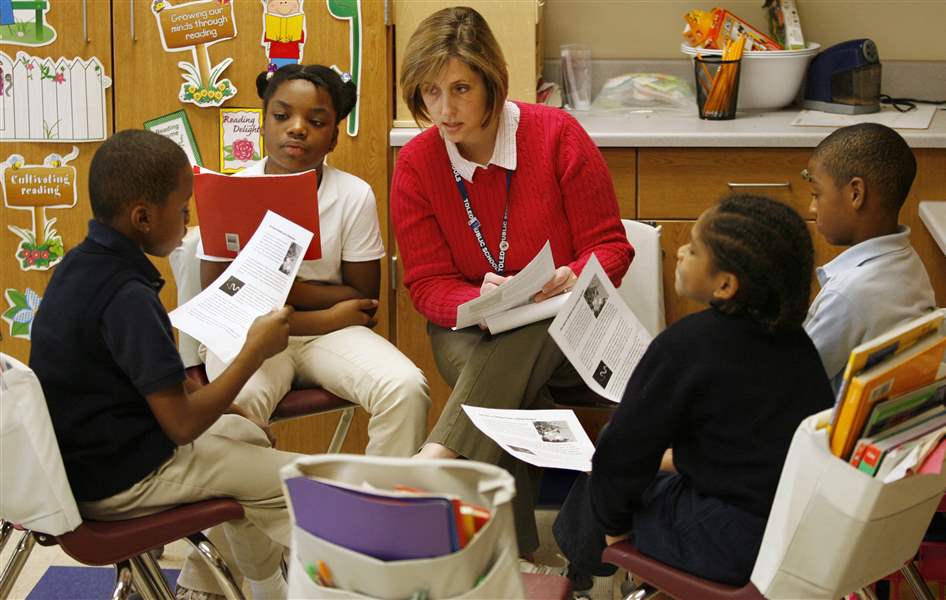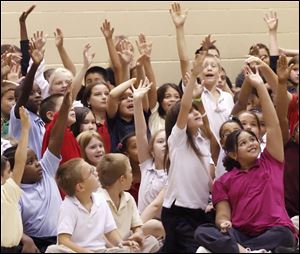
Toledo Public Schools holds ranking; test scores move up
8/24/2011
Diane Pickering, an intervention assessment teacher, oversees a reciprocal teaching group at Spring Elementary School in April.
THE BLADE
Buy This Image

Diane Pickering, an intervention assessment teacher, oversees a reciprocal teaching group at Spring Elementary School in April.
Toledo Public Schools made small gains on Ohio’s school report card last year, yet more schools were given the state’s lowest rank.
Toledo was rated in continuous improvement -- the equivalent of a C -- on Ohio’s six-level scale. The district’s overall score, called a performance index, increased to 83.1 on a 120 point scale, a bump of .5 points.
This is the fourth year in a row the state gave Toledo the continuous improvement ranking, and also the fourth straight year the school system made incremental improvements on test scores. The district’s performance index has risen from 79.1 in 2006-2007 school year.
But despite the overall increase, 10 schools were rated in academic emergency, the state’s lowest designation, up from nine last year.
While TPS has continued to make small gains, district leaders said the improvements are not enough, especially when many students continue to fail state standardized tests and schools remain in academic emergency.
“We made some improvements,” TPS chief academic officer Jim Gault said, “but we also realize that the improvements that have been made in the district are not to our satisfaction, nor to the satisfaction of our community, nor or parents, nor our students.”
District leaders predicted the lack of major improvement at Toledo schools, Mr. Gault said, and that anticipation was one of the major catalysts behind the district’s transformational plan.
SEARCH YOUR SCHOOL
• 2010-2011 Ohio Report Card by district
• 2010-2011 Ohio Report Card by school
Next week, schools will reopen, many with major changes.
The status quo could have continued to bring incremental growth, with the same familiar schools continuing to drag down the district’s score, officials said. The status quo isn’t enough.
“I think we are at a point right now that we are not satisfied with small, incremental growth,” Mr. Gault said.
The state released the report cards at 10 a.m. Wednesday. The annual assessments include a bevy of data, including graduation rates, results of the Ohio Academic Achievement exam and the Ohio Graduation Test, and show whether a district and its students continue to improve year-to-year. Much of the information is used to determine whether schools made “adequate yearly progress,” a determination of success under the No Child Left Behind Act.
How TPS schools fared
Of the 10 TPS schools designated as in academic emergency, two of them were actually small schools within Scott High School -- the Allied Health Academy and the Business Technology and Industry Academy. Scott moved away from small schools in the summer, and will return to a traditional format this year.

Students are eager to ask Detroit Pistons player Greg Monroe a question during the "Homework Before Hoops" presentation Sept. 14, 2010, at Birmingham Elementary.
The other academic emergency schools were Rosa Parks, Glenwood, Pickett, Sherman, and Spring elementary schools, along with Robinson and Samuel M. Jones at Gunckel Park middle school. All but Sherman and Spring are in the Scott learning community, and all the schools are central city schools.
Meanwhile, the number of schools rated excellent dropped from eight to five, a major disappointment for TPS staff. High schools Start, Toledo Early College, and the Toledo Technology Academy kept their high ratings, as did Beverly and Elmhurst elementary schools.
Grove Patterson Academy and Harvard Elementary both dropped to effective, though both schools’ test scores just missed the cutoff point for excellent. Perhaps the biggest disappointment in Toledo rankings this year was for Birmingham Elementary. The East Toledo school was a poster child last year for the district when it moved from continuous improvement to excellent. But this year, the school dropped back to the C ranking.
But it wasn’t all bad news on the school designation front.
While more schools ended up in academic emergency this year, Toledo saw significant improvements in the next category.
Only nine schools were rated in academic watch, the equivalent of a D, compared with 14 schools last year. Those schools were distributed between the Waite, Woodward, Rogers, and Scott learning communities. They were: Woodward High School, Ella P. Stewart Academy for Girls, Leverette and McTigue middle schools, and elementary schools Westfield, Riverside, Reynolds, Marshall, and Keyser.
COMING THURSDAY
More detail on the state report cards, including the story behind major successes and disappointments at some TPS schools, how a new way to measure graduation rates impacts area schools, how a new reading program showed measurable success at Toledo’s lowest performing schools, and more.
Some schools made major improvements last year.
Rogers High School moved from continuous improvement to effective, and its performance index score increased by nine points, a significant jump in one year. The Martin Luther King, Jr. Academy for Boys escaped the grips of academic emergency, moving two spots to continuous improvement.
Toledo district officials held a press conference at 10:30 a.m. Wednesday at the academy to discuss the district's report card results. Officials heralded the success at the all boy's school and detailed plans for improvement at buildings that continue to struggle.
In effect, Toledo experienced a central score grouping of its schools, with the majority of schools - 30 out of 54 - ranked either effective or continuous improvement.
State scores rise, Cincinnati shines
Ohio students as a whole showed growth in most areas compared to last year.
The statewide performance index increased by 1.7 points to 95, and on 21 of 26 indicators the percent of students scoring proficient increased.
And while Toledo has made incremental gains, one Ohio urban school district has managed continuously to outpace other major city school systems. Cincinnati became the first urban district to reach the effective designation last year, and retained that ranking again this year. Its performance index, meanwhile, jumped to 87.3 from 83.1 the year before.
Toledo school officials said Cincinnati has been able to out perform TPS largely because of its performance in special education, a frequent weak point for the Toledo district.
“Inclusion; that’s the main thing,” Mr. Gault said. “They started making their gains when they changed their special education services.”
Toledo officials are moving to a special education inclusion model -- where students remain in traditional classrooms -- this year, and expect significant test score increases.
Toledo Public Schools maintained its relative position compared to the “Big 8” of Ohio urban areas, with a performance index score behind Cincinnati, Akron, and Canton, but ahead of Columbus, Dayton, Cleveland, and Youngstown.
A piece of good news, in a relative sense, for Ohio came with Youngstown moving from academic emergency to academic watch, meaning no district’s in the state ranked an F this year. Meanwhile the number of districts ranked excellent or excellent with grew by 56 to 352.

Woodmore High School students board their buses in front of the school in April.
Suburban schools
In northwest Ohio, school districts Northwood, Rossford, and Woodmore received the state’s highest designation, “excellent with distinction.”
Both Woodmore and Northwood’s rankings resulted in major jumps from prior years, as the districts were both ranked effective, two rungs below. The districts were aided in their value added scores, a measurement of student growth. High value added scores can garner a district a boost in the state rankings.
One notch below, in the “excellent” category, were Anthony Wayne, Lake Local, Maumee, Otsego, Ottawa Hills, Perrysburg, Springfield, Swanton, and Sylvania. In the effective category were Genoa, Oregon, and Washington Local.
Charter schools
Last year, only one Lucas County charter school - the Toledo School for the Arts - was rated excellent on state report cards. This year, TSA was joined by the Toledo Preparatory and Fitness Academy on Arco Drive.
This is the sixth year in a row TSA has earned the distinction. The arts school in Toledo’s Uptown district enrolls nearly 600 students and mixes a traditional college preparatory program with visual and performing arts classes.
Two schools that provide specialized instruction for students with autism weren’t ranked, but their test scores exceeded those of all other charter schools in Lucas County.
Though the number of excellent charter schools grew, far more charters schools were given the state’s lowest distinction. Of the 35 Lucas County charter schools, eight were rated in academic emergency. Those schools were: Achieve Career Preparatory Academy, Eagle Learning Center, Lake Erie Academy, Phoenix Academy Community School, Polly Fox Academy Community School, Summit Academy Community School, Toledo Preparatory Academy, and Victory Academy of Toledo.
The number of charters in academic emergency actually decreased by one compared to last year, though the state closes charter schools after they have failed for several years in a row, meaning chronically failing schools would drop off the list.
Of the remaining charter schools, 11 were in academic watch, 10 were in continuous improvement, and two were rated effective.
Contact Nolan Rosenkrans at:
nrosenkrans@theblade.com
or 419-724-6086.